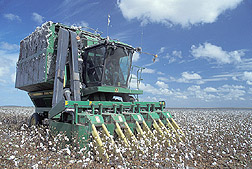This page has been archived and is being provided for reference purposes only. The page is no longer being updated, and therefore, links on the page may be invalid.
|
Read the magazine story to find out more. |
Moisture in Cotton: Getting It Just RightBy Luis PonsMay 21, 2002 Maintaining proper moisture in cotton bales is critical for successful textile processing. Too little moisture makes cotton susceptible to damage, while too much makes it stick to machinery components. That is why Agricultural Research Service scientists are working with a Tennessee-based company to find easier ways to regulate moisture throughout processing. The work at the ARS Cotton Quality Research Unit in Clemson, S.C., is part of a three-year cooperative research and development agreement with Cotton Conditioners, Inc., of Knoxville, Tenn. The goal is to see how various approaches tried in the lab hold up in a real-world setting. Researchers also want to develop, evaluate and commercialize an effective automated system to control moisture in cotton during processing in textile mills. In the laboratory tests, ARS scientists led by textile technologist David D. McAlister sought to determine precise amounts of moisture needed to best maintain fiber properties, improve processing and increase yarn quality. The amount of moisture added will vary from process to process, based upon factors such as the cotton’s variety, surface wax and cleanability. The scientists used various methods to condition samples taken from bales of cotton. Some samples were left in ambient room conditions, while others were sprayed with water, both with and without a wetting agent to improve absorption. The team then measured fiber properties and yarn tensile strength of each sample to see which moisture level most improved the cotton fiber’s ability to be processed. Cotton is the world’s most widely used textile fiber, with U.S. growers providing 20 percent of the world’s output. Read more about this research in the May issue of Agricultural Research magazine. ARS is the chief scientific research agency of the U.S. Department of Agriculture. |

